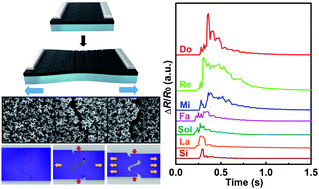Ultrasensitive micro/nanocrack-based graphene nanowall strain sensors derived from the substrate's Poisson's ratio effect†
Abstract
Highly sensitive wearable strain sensors based on graphene and its derivatives have shown great potential to be applied in home monitoring and electronic skin. To date, it still remains a technical challenge to achieve a reliable performance with high responsiveness at a small elastic strain for graphene strain sensors. Here we demonstrate the fabrication of micro/nanocrack-based strain sensors by using a porous thin film composed of graphene nanowalls (GNWs), which showed ultrahigh sensitivity with a gauge factor up to ≈8.6 × 104 at 4% strain. The ultrahigh gauge factor at such a small deformation can be attributed to the synergistic effect of micro/nanocrack evolution of GNW building blocks derived from the substrate's Poisson's ratio effect. This working mechanism is distinct from the general case where the cracks were created in an initially continuous film. The wearable GNW strain sensors were functionally presented as audio analog-to-digital converters for acoustic signature recognition and electronic skin devices to monitor physiological signals from the human body at high resolution.



 Please wait while we load your content...
Please wait while we load your content...